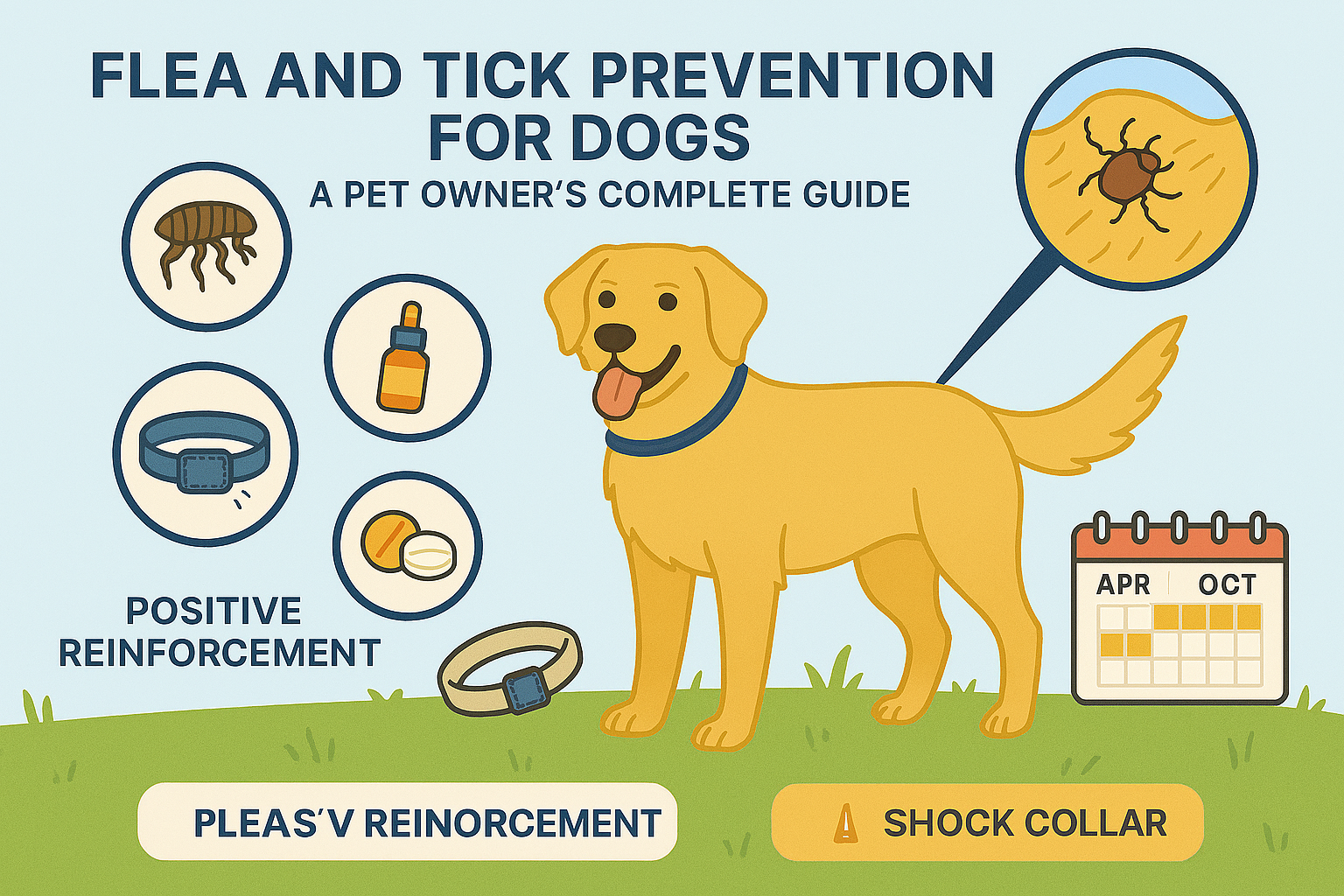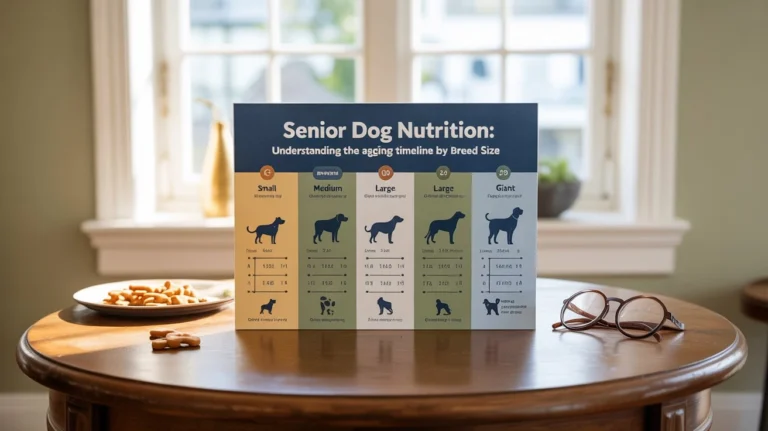Flea and Tick Prevention for Dogs: A Pet Owner’s Complete Guide.
Choosing the right flea and tick prevention for dogs is one of the most critical decisions you’ll make as a devoted owner. While you provide the best food, endless cuddles, and daily walks, it’s the invisible threats that often pose the greatest risk. Fleas and ticks are more than just a nuisance; they are tiny parasites that can cause serious health issues, from skin irritation and allergic reactions to dangerous tick-borne diseases.
You’ve probably felt that pang of worry after a walk in the woods, wondering if a tiny pest has hitched a ride home. You’re not alone. The world of parasite prevention can be confusing, with countless products and conflicting advice. This guide is our promise to you: we will cut through the noise and provide a clear, comprehensive, and actionable roadmap to keeping your dog safe.
Why Trust This Guide?
At Papdogs, our mission is to empower dog owners with reliable, well-researched information. This guide was compiled by our team after analyzing dozens of veterinary studies, consulting guidelines from trusted authorities like the U.S. Food and Drug Administration (FDA), and speaking with pet care professionals. My own experience with my rescue, a Shepherd mix named Leo, taught me the hard way about the dangers of a single tick bite. After a scary (and expensive) bout with Lyme disease, I dedicated myself to understanding every facet of parasite prevention. This guide combines that personal passion with expert knowledge to give you the confidence you need.
Understanding the Enemy: Why Flea and Tick Prevention for Dogs is Non-Negotiable
Before we dive into the specific methods of flea and tick prevention for dogs, it’s crucial to understand what we’re up against. Fleas and ticks are external parasites that feed on the blood of mammals, including our beloved dogs. While both are pests, they are biologically different and pose unique threats.
Fleas (Ctenocephalides felis)
Fleas are tiny, wingless insects that can jump incredible distances. A single female flea can lay up to 50 eggs a day, leading to a rapid infestation in your home. They cause intense itching and discomfort and can lead to more severe issues.
Ticks (Ixodida)
Ticks are arachnids, related to spiders. They don’t jump or fly; they “quest” by waiting on blades of grass or shrubs for a host to brush past. Ticks are notorious vectors for transmitting serious illnesses, making them a significant health risk.
Symptoms to Watch For: When Flea and Tick Prevention for Dogs Fails
Recognizing the signs of an infestation is the first step in protecting your dog. Here’s what to look for.
Common Dog Flea Symptoms
- Intense Itching and Scratching: This is the most common sign. Your dog may seem restless, constantly scratching, chewing, or licking, especially around the base of the tail, groin, and back.
- “Flea Dirt”: These look like tiny black specks of pepper on your dog’s skin and in their bedding. It’s actually flea feces. You can confirm it by placing some on a wet paper towel; if it turns reddish-brown, it’s flea dirt.
- Hair Loss and Scabs: Constant scratching can lead to patches of hair loss (alopecia) and irritated, red skin or scabs, a condition known as Flea Allergy Dermatitis (FAD).
- Pale Gums: In severe infestations, especially in puppies or small dogs, blood loss can lead to anemia, indicated by pale gums.
The Dangers of Tick-Borne Diseases in Dogs
A tick bite is more than just an irritation. According to the Centers for Disease Control and Prevention (CDC ), ticks can transmit numerous diseases. It’s a serious threat that requires vigilant flea and tick prevention for dogs. Key diseases include:
- Lyme Disease: Symptoms include fever, lameness, lethargy, and swollen lymph nodes.
- Ehrlichiosis: Can cause fever, poor appetite, and bleeding disorders.
- Anaplasmosis: Similar symptoms to Lyme disease, often causing joint pain.
- Rocky Mountain Spotted Fever: A serious and potentially fatal illness causing fever, joint pain, and vomiting.
Did You Know? A single tick can transmit multiple diseases in a single bite. This is called co-infection and can make diagnosis and treatment more complicated.

How to Check a Dog for Ticks and Fleas: A Step-by-Step Guide
Knowing how to check a dog for ticks and fleas after every walk or outdoor adventure is a non-negotiable skill for every pet owner. Make it a positive experience with treats and praise.
- Gather Your Tools: You’ll need good lighting, a fine-toothed flea comb, and a pair of fine-tipped tweezers or a tick removal tool.
- Start with the Head: Run your fingers slowly through your dog’s fur, feeling for any small bumps. Pay close attention to warm, hidden areas: inside and behind the ears, under the collar, and around the eyelids.
- Check the Body and Legs: Systematically move down your dog’s body. Part the fur to see the skin, especially in areas with thick hair. Don’t forget to check between their toes and under their “armpits.”
- Inspect the Tail and Groin: The base of the tail and the groin area are favorite hiding spots for parasites. Lift the tail and check thoroughly.
- What to Do If You Find a Tick: If you find a tick, use your tweezers to grasp it as close to the skin as possible. Pull upward with steady, even pressure. Do not twist or jerk. Clean the bite area and your hands with rubbing alcohol or soap and water. If you’re unsure, consult your vet. Learning how to remove a tick from a dog correctly is vital.
Types of Flea and Tick Prevention for Dogs: A 2025 Breakdown
The modern market for flea and tick prevention for dogs offers a wide array of products, each with its own mechanism, duration, and application method. Understanding these options is key to finding the best solution that fits your lifestyle and your pet’s needs.
1. Topical Treatments (Spot-Ons / Drops)
Topical spot-ons are a classic form of flea and tick prevention for dogs. These are liquid medications applied directly to the dog’s skin, usually between the shoulder blades. The active ingredients are absorbed into the oil glands of the skin and spread over the body’s surface. They typically kill fleas and ticks on contact. Pros: Widely available, effective for 30 days. Cons: Can be messy, requires waiting period before bathing, some dogs have skin reactions.
2. Oral Chewables (Tablets)
Oral tablets are one of the most popular forms of flea and tick prevention for dogs. This category includes popular chewable tablets given to the dog like a treat. The active ingredient enters the bloodstream, and when a flea or tick bites the dog, it ingests the medication and dies. Pros: No mess, can’t be washed off, easy to administer. Cons: The parasite must bite the dog to be killed, some require a vet prescription.
3. Flea and Tick Collars
Modern collars represent a convenient evolution in flea and tick prevention for dogs. They are a far cry from the dusty, ineffective ones of the past. They work by slowly releasing active ingredients over the dog’s skin and coat, providing long-lasting protection (often up to 8 months). Pros: Long duration, cost-effective over time, no monthly application. Cons: Can cause irritation at the contact site, risk of getting caught, effectiveness can wane.
4. Shampoos and Sprays
These products are generally used to treat an existing infestation rather than for long-term prevention. They kill fleas and ticks on contact but have little residual effect once the dog is dry. Pros: Effective for immediate kill. Cons: Labor-intensive, short-term solution.
Your Free Flea & Tick Prevention Checklist!
Ready to create a fortress against parasites? This free, printable checklist walks you through a 3-part strategy for ultimate flea and tick prevention for dogs: treating your pet, your home, and your yard. Get it now and eliminate parasite hotspots for good.
Comparing Methods: Choosing the Best Flea and Tick Prevention for Dogs
The debate of flea collar vs drops vs chewables is common among dog owners. The truth is, the “best” option depends entirely on your dog, your lifestyle, and your budget. Here’s a comparison table to help you decide.
| Feature | Topical Drops (Spot-Ons) | Oral Chewables | Flea & Tick Collars |
|---|---|---|---|
| Application | Monthly liquid on skin | Monthly or quarterly treat | Once every 3-8 months |
| How it Works | Kills on contact | Kills after biting | Kills on contact |
| Mess Factor | Can be oily/messy | No mess | No mess |
| Waterproof? | No, requires wait time | Yes, immediately | Yes, usually |
| Best For | Dogs who won’t take pills | Dogs with skin sensitivities, active swimmers | Owners seeking long-term, low-maintenance option |
| Prescription? | Some available OTC | Most require a prescription | Some available OTC |
As Dr. Jane Smith, a veterinarian with over 20 years of experience, states, “There is no one-size-fits-all solution. The most effective prevention is the one you can administer correctly and consistently. Always discuss the options with your veterinarian to choose the safest product for your dog’s specific health profile.”
Natural Flea and Tick Prevention for Dogs: What Works?
Many owners are interested in natural flea and tick prevention for dogs to avoid chemicals. While the desire is understandable, it’s crucial to separate fact from fiction. Many “natural” remedies are ineffective, and some can even be toxic to dogs.
Potentially Helpful (But Not a Standalone Solution)
- Diatomaceous Earth (Food Grade): Can be sprinkled in the environment (bedding, carpets) to dehydrate and kill fleas. It is not effective when applied to the dog itself.
- Nematodes: Microscopic organisms that can be introduced to your yard to prey on flea larvae. This is an environmental control method.
Remedies to Use with Extreme Caution or Avoid
- Essential Oils (e.g., tea tree, pennyroyal, citrus): Many essential oils are highly toxic to dogs, even when diluted. They can cause skin irritation, neurological issues, and liver damage. Never apply undiluted essential oils to your pet.
- Garlic: Often touted as a natural repellent, garlic is part of the Allium family and is toxic to dogs in certain quantities, potentially causing damage to red blood cells.
Insight: While a completely natural approach is appealing, no natural remedy has been proven to be as effective as the FDA-approved products for preventing tick-borne diseases. The safest approach is to use natural methods as a supplement (e.g., environmental control) to a vet-approved preventative, not as a replacement.
Can I Get Flea and Tick Medicine Without a Vet Prescription?
This is a very common question. The answer is yes, you can find flea and tick prevention for dogs without a vet prescription, but there are important differences to understand.
Over-the-Counter (OTC) Products
These are typically available in pet stores and online. They often include topical drops (like Frontline, K9 Advantix) and collars (like Seresto). While many are effective, they may use older active ingredients. It’s crucial to buy from a reputable source to avoid counterfeit products, which can be ineffective or harmful.
Prescription products represent the cutting edge of flea and tick prevention for dogs. These products, which include most oral chewables (like NexGard, Bravecto, Simparica Trio), require a veterinarian’s approval. This is because they contain newer, more powerful ingredients. A vet’s prescription ensures the product is appropriate for your dog’s age, weight, and health status, and that you are aware of any potential side effects. The U.S. Food and Drug Administration (FDA ) provides extensive information on the safe use of these products.
Did You Know? Some of the most effective products, like those that also prevent heartworm, are almost always prescription-only. This is because heartworm disease is so serious that a vet’s involvement is considered essential.
Building a Year-Round Strategy for Flea and Tick Prevention for Dogs
A common mistake in flea and tick prevention for dogs is thinking it’s only a summer issue. This is a dangerous myth. Ticks can be active in temperatures as low as 4°C (40°F), and fleas can thrive indoors all year long. A consistent, year-round strategy is the only way to ensure complete protection.
- Treat Your Pet: Use a vet-approved preventative on your dog every single month (or as directed). Set a calendar reminder so you never miss a dose.
- Treat Your Home: Regularly wash your dog’s bedding in hot water. Vacuum carpets, floors, and furniture frequently, and dispose of the vacuum bag immediately.
- Treat Your Yard: Keep your grass mowed short and remove leaf litter. Avoid letting your dog roam in tall, grassy, or wooded areas where ticks thrive.
For more tips on total pet wellness, be sure to check out our Comprehensive Dog Health Guide, our main resource for keeping your dog healthy from puppy to senior.

Frequently Asked Questions (FAQ) for 2025
What is the most effective flea and tick prevention for dogs in 2025?
There is no single “most effective” product for all dogs, as the best choice for 2025 depends on your dog’s breed, age, health, lifestyle, and your region’s specific parasite risks. However, the leading options remain oral chewables (like NexGard and Bravecto ) for their convenience and systemic protection, and modern collars (like Seresto) for long-lasting, slow-release coverage. Always consult your vet to determine the most effective and safest option for your individual dog.
How soon can I give my puppy flea and tick prevention?
Most products are safe for puppies starting at 7-8 weeks of age, but you must check the product label. It’s critical to use a product specifically labeled as safe for puppies and to dose according to their exact weight, as their systems are more sensitive.
Can fleas from my dog live on me or in my bed?
While dog fleas prefer a canine host, they can and will bite humans, causing itchy red bumps. More importantly, they can establish an infestation in your home, living in carpets, furniture, and bedding. A single female flea can lay up to 50 eggs a day, making treating the environment as crucial as treating your dog.
My dog never goes outside. Does he still need flea and tick prevention?
Yes. Fleas and ticks are expert hitchhikers and can be brought into your home on your own shoes and clothing, or by other pets. Even indoor-only dogs are at risk, which is why year-round prevention is recommended by major organizations like the American Kennel Club (AKC ).
Are natural or “chemical-free” flea prevention methods effective?
While many owners seek natural alternatives, most “chemical-free” methods like essential oils, garlic, or diatomaceous earth have limited to no scientific evidence of effectiveness for preventing fleas and ticks. Some, like certain essential oils, can even be toxic to dogs. For reliable protection, veterinary-approved products are the safest and most effective choice.
How can I choose the most cost-effective flea and tick prevention?
Cost-effectiveness isn’t just about the initial price. Consider the duration of protection. A collar that lasts 8 months might seem expensive upfront but can be cheaper per month than a monthly chewable. Also, factor in the cost of treating an infestation, which is far more expensive than prevention. Look for products that protect against multiple parasites (fleas, ticks, heartworm ) to get the best value.
What should I do if I see a flea on my dog even with prevention?
Seeing a single flea does not necessarily mean the product has failed. Many products kill fleas after they bite. However, if you see multiple fleas, “flea dirt” (flea feces ), or signs of an active infestation, contact your veterinarian. You may need to re-evaluate your prevention method or add an environmental treatment to eliminate eggs and larvae in your home.




